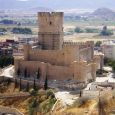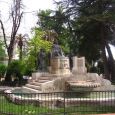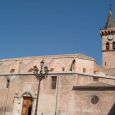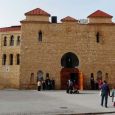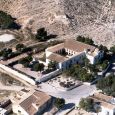Villena
Advertisement
By road
Villena is located in the enclave known as Corridor or Corridor Vinalopo Villena, which has favored the development of good infrastructure in communication networks motorway, which link to the plateau and the coast of Alicante, as well as Andalusia, Valencia and Alcoy. In addition, through a series of local and county roads, communicates with the neighboring towns that form the natural river district Vinalopó and with the Hoya de Alcoy - Cocentaina County, the Valley Albaida as well as with neighboring towns in the provinces of Murcia and Albacete, such as Yecla and Caudete. Thus, it takes an average of 40 minutes and access to Alicante airport Altet, and an access time cities such as Valencia, Murcia and Albacete.
By railway
Villena in his municipality has two railway stations since 1858, the station Villena in the urban and the Encina station in the hamlet of La Encina. In Villena station all stop long-haul trains Talgo and Alvia, the international train Mare Nostrum and the Regional Valencia-Alicante, Valencia, Murcia, Valencia and Alicante-Cartagena, Ciudad Real. The Encina station was an important hub of communications between Madrid, Alicante and Valencia to the 1970's, when its importance fell to construct a variant between Alicante and Valencia which made it unnecessary to stop at this station.
Advertisement
Historic Centre of Villena
The historic center of Villena is located around the castle Atalaya, a small spur of the Sierra de la Villa. It consists of two originally distinct nuclei: The Rabal, which extends to the west of the present Church of St. Mary, under whose sun had found the mosque, and how close or the City, which was formed around the church of Santiago following the Christian conquest and was walled by Don Juan Manuel.
Atalaya Castle
Atalaya Castle Villena or stands on a spur of Mount San Cristobal or the villa in the town of Villena, northwest of the province of Alicante, near the line separating the province of Albacete and dominates the old border in Castile and Aragon. It was built by the Arabs at an unknown date, but not after the twelfth century, since the sources Arabs already mentioned in the year 1172. It has been much speculation about the possibility that the strength to sit on a fortification or Roman villa above, but archeology has thrown light on this issue.
Palacio Municipal de Villena
The Palacio Municipal de Villena was built by Pedro de Medina in the early sixteenth century for dwelling beneficiaries master of the Temple of Santiago (Abbey House). Was alienated in 1576 by the cathedral chapter, and acquired by the City Council for Town Hall.The valuation of the building is due to its Renaissance character, clearly mark on its facade, in two of its windows and double patio with stairs built gallery.
Archpriest of St. James Church
Archpriest Church of Santiago de Villena is located on the square of Santiago of the CIDU. Began to be built in the fourteenth century, though its present appearance dates from the sixteenth century. It is the largest and most important church of Villena, and this is one of the sets Gothic - renancentistas most important Valencia since formed the archetype of an architectural school had wide resonance region.
Church of Santa Maria
The church of Santa Maria is a temple Catholic located in Villena, Alicante.The church of Santa Maria was built over an ancient Muslim mosque in the sixteenth century to become the church of Santa Maria or Rabal. It has a single nave, which seems to become when drilling three buttresses inside. Its polygonal apse has not ambulatory, and downloaded vaults pillars with half terraced Renaissance reliefs are engraved.
Shrine of Our Lady of Virtues
The Shrine of Our Lady of Virtues, also called the Virtues Monastery is located in the hamlet of Virtues, the town of Villena. Located in a natural setting next to a former lagoon, now dried, and about 5 km from the city, near the Fountain of Poplar.
Round Head
The round head is an archaeological site in the Bronze Age that is located 2 km from Villena ( Alicante ). This is not a village, but a true market town that was inhabited between 1500 and 1100 a. C. and probably belonged to the Argaric. It is speculated that the first investigations were conducted by John Vilanova i Piera to 1870, although it was the archaeologist Jose Maria Soler who began to study systematically in 1959, following the discovery of the Round Head Tesorillo, preserved in the Archaeological Museum Villena.
Villena Bullring
The plaza de toros de Villena was opened in 1924. It is one of the few arenas in the province of Alicante and had seating for 10,000 people. It reopened on March 26 of 2011. It is a work of interest for its large size, solid character, exempt status and formal features of its architecture: access and Neoarabic pointed arched windows, and eaves metal pilarcillos top floor. For this bullring has fought Antonio Ordonez, Juan Antonio Ruiz "Spartacus", Francisco Rivera "Paquirri", Jaime Ostos, Manuel Benitez "El Cordobes" and Miguel Baez "Litres" .
Castillo de Salvatierra
The Castillo de Salvatierra, popularly known as the castle is on the retreat of the Sierra de la Villa, in the town of Villena, Alicante. It was built during the tenth century and lasted until the fourteenth century, when it abandoned to the Castle of the Watchtower. Since it can be seen interlocking valleys Biar, Benejama and Villena, and the towns of Yecla and Caudete. Currently the building is in ruins and only retains a small part of it
Ermita de Nuestra Senora del Pilar
The shrine of Our Lady of Pilar is located in the Valley of the Alhorines in the municipality of Villena. It is located in the middle of the garden, about 5 km from both the Encina as La Zafra, in the departure of La Gloria, and attached to a large house with two floors and a farmhouse called Casa Conejo.
Rupert Chapi Monument
Rupert Chapi Monument is Located on the Paseo de Chapi and was built in 1947 Villena sculptor Antonio Navarro Santa Fe. It is chaired by a seated sculpture of Chapi, the allegorical figures surrounding two of his works: The witch, on the left and the Revoltosa on your right. In 1998, due to the significant deterioration of the stone was replaced by the current replica in bronze. The original sculpture presides Chapi the theater lobby.
June - August
Information not available
Advertisement

